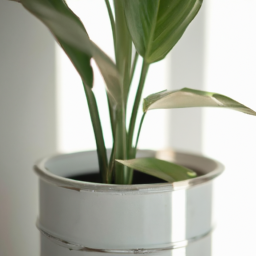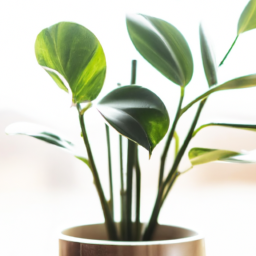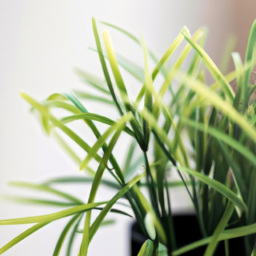
Are you looking to spruce up your bedroom with a touch of nature? Adding indoor plants to your bedroom can not only enhance the aesthetic appeal of the space but also bring numerous benefits to your overall well-being. In this blog post, we will explore the world of indoor plants for the bedroom and discover which varieties are best suited for creating a serene and soothing environment. So, if you’re ready to transform your bedroom into a green oasis, let’s dive right in!
Benefits of Indoor Plants in the Bedroom
Indoor plants can bring life and beauty to any space, and the bedroom is no exception. Not only do they add a touch of nature to your sleeping sanctuary, but they also offer numerous benefits for your health and well-being. In this guide, we will explore the various advantages of having indoor plants in your bedroom and provide you with a step-by-step guide to choosing the perfect plants for your space.
Improved Air Quality
One of the primary benefits of indoor plants in the bedroom is their ability to improve air quality. Plants naturally absorb carbon dioxide and release oxygen through the process of photosynthesis. This can help increase the oxygen levels in your bedroom, leading to better air quality and a more restful sleep.
In addition to producing oxygen, many indoor plants also have the ability to filter out harmful toxins from the air. Common indoor plants such as the Snake Plant, Spider Plant, and Peace Lily are known for their air-purifying properties. These plants can remove pollutants like formaldehyde, benzene, and trichloroethylene, which are commonly found in household products, from the air, creating a healthier environment for you to sleep in.
Furthermore, indoor plants can help regulate humidity levels in your bedroom. They release moisture through a process called transpiration, which can help combat dry air and reduce the risk of respiratory issues, particularly during the winter months when heating systems can cause the air to become dry.
Natural Stress Relief
In today’s fast-paced world, stress has become a common issue for many individuals. Having indoor plants in your bedroom can provide a natural and effective way to reduce stress levels and promote relaxation. Studies have shown that being around plants can help lower blood pressure, reduce anxiety, and improve overall mood.
The presence of greenery in your bedroom can create a calming and soothing atmosphere, helping you unwind after a long day. The act of caring for plants, such as watering and nurturing them, can also be therapeutic and provide a sense of purpose and responsibility.
Plants like Lavender, Jasmine, and Aloe Vera are known for their calming properties and pleasant fragrances. Placing these plants in your bedroom can contribute to a more peaceful and restorative sleep, allowing you to wake up feeling refreshed and rejuvenated.
Natural Sleep Aid
Having trouble falling asleep or staying asleep? Indoor plants can act as natural sleep aids by promoting a more conducive sleep environment. Certain plants, such as the Snake Plant and the Aloe Vera, release oxygen at night instead of during the day, making them ideal bedroom companions.
The increased oxygen levels provided by these plants can improve the quality of your sleep and reduce the likelihood of sleep disturbances. Additionally, plants like the English Ivy and the Spider Plant have been found to effectively reduce indoor air pollutants, such as mold spores, which can trigger allergies and disrupt sleep.
When choosing plants for your bedroom, it’s important to consider their specific care requirements and any potential allergies you may have. Opt for low-maintenance plants that thrive in low-light conditions, as bedrooms generally have less natural light compared to other areas of the house.
Choosing the Perfect Plants for Your Bedroom
Now that you’re aware of the benefits of indoor plants in the bedroom, let’s explore how to choose the perfect plants for your space:
1. Assess Lighting Conditions
Start by evaluating the lighting conditions in your bedroom. Determine whether your space receives direct sunlight, indirect sunlight, or is mostly shaded. This will help you select plants that can thrive in your specific lighting environment.
For low-light bedrooms, consider plants like the Snake Plant, ZZ Plant, or Pothos, which are known for their ability to tolerate low-light conditions. If your bedroom receives ample natural light, options like the Peace Lily, Spider Plant, or Rubber Plant would be suitable choices.
2. Consider Maintenance Needs
Next, think about the level of maintenance you’re willing to commit to. Some plants require more care and attention than others. If you’re a beginner or have a busy lifestyle, opt for low-maintenance plants that don’t require frequent watering or special care.
Plants like the Snake Plant, Spider Plant, or Aloe Vera are excellent choices for those who prefer low-maintenance options. These plants are known for their resilience and ability to tolerate neglect.
3. Choose Plants with Air-Purifying Properties
If improving air quality is a priority for you, consider selecting plants that have air-purifying properties. As mentioned earlier, plants like the Snake Plant, Spider Plant, and Peace Lily are excellent choices for their ability to filter out toxins from the air.
Additionally, plants with broad leaves or dense foliage are generally more effective at purifying the air. They have a larger surface area to absorb pollutants and release oxygen.
By following these steps, you can find the perfect indoor plants for your bedroom that not only enhance the aesthetic appeal but also provide numerous health benefits. Remember to regularly care for your plants by watering them appropriately and providing the necessary light and nutrients. With a little greenery in your bedroom, you can create a peaceful and rejuvenating space for a restful night’s sleep.

Best Indoor Plants for a Relaxing Bedroom Environment
Welcome to our guide on the best indoor plants for creating a relaxing bedroom environment. Adding plants to your bedroom not only enhances the aesthetic appeal but also brings numerous benefits to your overall well-being. In this article, we will explore different indoor plants that are well-suited for bedrooms, considering factors such as air purification, calming effects, and ease of maintenance.
Aloe Vera
Aloe Vera is a popular indoor plant known for its air-purifying properties and soothing effects. It releases oxygen at night, making it an ideal choice for the bedroom. Additionally, Aloe Vera is low maintenance and requires minimal watering. Its gel can also be used for various medicinal purposes, including treating minor burns and moisturizing the skin.
When placing Aloe Vera in your bedroom, ensure it receives bright, indirect sunlight. Avoid overwatering and allow the soil to dry out between waterings. Aloe Vera can thrive in a wide range of temperatures, making it suitable for most bedroom environments.
Incorporating Aloe Vera into your bedroom not only adds a touch of greenery but also promotes better air quality, helping you relax and sleep better at night.
Lavender
Lavender is well-known for its calming and soothing aroma, making it a perfect choice for creating a peaceful bedroom environment. The fragrance of lavender has been shown to reduce anxiety levels and improve sleep quality. Having a lavender plant in your bedroom can help you unwind after a long day and promote a restful night’s sleep.
When growing lavender indoors, ensure it receives at least six hours of direct sunlight each day. Keep the soil slightly dry between waterings, as lavender prefers well-drained soil. Pruning the plant regularly will encourage bushier growth and enhance the release of its delightful fragrance.
In addition to its aromatic benefits, lavender also adds a touch of beauty to your bedroom with its vibrant purple flowers. Consider placing a lavender plant on your nightstand or windowsill to enjoy its calming effects.
Snake Plant
Snake plants, also known as Sansevieria, are excellent bedroom companions due to their ability to purify the air and release oxygen at night. They are particularly effective in removing toxins such as formaldehyde, benzene, and xylene, which can be found in common household products.
Snake plants are incredibly resilient and can tolerate low light conditions, making them perfect for bedrooms with limited natural light. They also require minimal watering, as they store water in their leaves. However, it’s important not to overwater them, as this can lead to root rot.
Consider placing a snake plant near your bedroom window or in a corner that receives indirect sunlight. Its unique vertical growth pattern adds a touch of elegance to your bedroom while improving the air quality, helping you breathe better and enjoy a more peaceful sleep.
By incorporating these indoor plants into your bedroom, you can create a relaxing environment that promotes better sleep, reduces stress levels, and enhances overall well-being. Remember to choose plants that suit your bedroom’s lighting conditions and your ability to provide care. Enjoy the benefits of nature in the comfort of your own bedroom!

Tips for Choosing and Caring for Indoor Plants in the Bedroom
Welcome to our guide on choosing and caring for indoor plants in the bedroom. Having plants in your bedroom not only adds a touch of nature to your space but also offers numerous benefits such as improved air quality, reduced stress levels, and better sleep. In this article, we will provide you with expert tips on selecting the right indoor plants for your bedroom and how to care for them effectively.
Choosing the Right Indoor Plants
When it comes to choosing indoor plants for your bedroom, there are a few factors to consider. First and foremost, you need to assess the lighting conditions in your bedroom. Most bedrooms have limited natural light, so it’s important to select plants that can thrive in low-light environments. Some excellent options include:
1. Snake Plant (Sansevieria Trifasciata): Snake plants are known for their ability to tolerate low light and neglect. They have long, upright leaves that come in various shades of green. Snake plants release oxygen at night, making them ideal for bedrooms.
2. Peace Lily (Spathiphyllum): Peace lilies are elegant plants that can add a touch of beauty to any bedroom. They can tolerate low light but prefer slightly brighter conditions. Peace lilies also help improve air quality by removing toxins from the air.
3. Pothos (Epipremnum Aureum): Pothos is a popular indoor plant that thrives in low-light conditions. It has heart-shaped leaves that come in various shades of green. Pothos is easy to care for and can even tolerate occasional neglect.
Once you have considered the lighting conditions, you should also think about the size of the plant and how it will fit into your bedroom space. Some plants, like the Snake Plant and Peace Lily, can grow quite tall, while others, like Pothos, have a trailing growth habit that can be placed on shelves or hanging baskets.
Lastly, it’s important to take into account any allergies or sensitivities you may have. Some plants release pollen or have strong fragrances that can cause discomfort to certain individuals. If you have allergies, it’s best to choose plants with low pollen production or opt for plants that purify the air without releasing significant amounts of allergens.
Caring for Indoor Plants in the Bedroom
Now that you have chosen the perfect indoor plants for your bedroom, it’s essential to provide them with the proper care to ensure their health and longevity. Here are some essential tips for caring for your indoor plants:
1. Watering: Most indoor plants prefer slightly moist soil, but overwatering can lead to root rot. It’s important to check the moisture level of the soil before watering. Stick your finger about an inch deep into the soil, and if it feels dry, it’s time to water. Use room temperature water and water thoroughly until it drains out of the bottom of the pot.
2. Light: While bedroom lighting conditions may be limited, it’s still important to provide your plants with the right amount of light. Place them near a window where they can receive indirect sunlight. Rotate the plants periodically to ensure even growth and prevent them from leaning towards the light source.
3. Temperature and Humidity: Most indoor plants prefer temperatures between 60-75°F (15-24°C). Avoid placing them near drafts or heating/cooling vents. Additionally, maintaining moderate humidity levels is beneficial for most plants. You can increase humidity by placing a tray of water near the plants or using a humidifier.
4. Fertilizing: Indoor plants generally require less fertilization compared to outdoor plants. During the growing season (spring and summer), you can feed your plants with a balanced liquid fertilizer once a month. In the dormant season, reduce or stop fertilization altogether.
5. Pruning and Maintenance: Regular pruning helps maintain the shape and health of your indoor plants. Remove any dead or yellowing leaves, and trim back overgrown branches. Wipe the leaves with a damp cloth to remove dust and keep them clean. Inspect your plants regularly for pests, such as spider mites or mealybugs, and take appropriate measures if needed.
By following these care tips, your indoor plants will thrive and provide you with a peaceful and refreshing atmosphere in your bedroom.
Conclusion
Indoor plants can transform your bedroom into a tranquil and rejuvenating space. By choosing the right plants and providing them with proper care, you can enjoy their numerous benefits while adding a touch of nature to your personal sanctuary. Remember to consider lighting conditions, plant size, and any allergies when selecting indoor plants for your bedroom. Additionally, follow the watering, light, temperature, and maintenance guidelines to ensure the health and vitality of your plants. Happy gardening and sweet dreams!
Essential Points
Indoor plants have become increasingly popular in recent years, and for good reason. Not only do they add a touch of greenery to our homes, but they also have numerous health benefits. And what better place to have some indoor plants than in our bedrooms? Not only do they create a calming and relaxing atmosphere, but they also purify the air, helping us to sleep better at night.
One of the best indoor plants for the bedroom is the snake plant. This plant is known for its ability to absorb toxins from the air, making it an excellent choice for improving indoor air quality. Additionally, snake plants are low-maintenance and can tolerate low light conditions, making them perfect for bedrooms with limited sunlight. Another great option is the peace lily, which not only purifies the air but also adds a touch of elegance to any space. With its beautiful white flowers and glossy green leaves, the peace lily is a popular choice for bedrooms. It thrives in low to medium light conditions and is relatively easy to care for.
Let me leave you with some FAQs:
Q1: What are the best indoor plants for a bedroom?
A1: The best indoor plants for a bedroom are those that thrive in low light conditions and help purify the air. Some popular choices include snake plants, peace lilies, spider plants, and pothos. These plants not only add a touch of greenery to your bedroom but also contribute to a calming and relaxing atmosphere.
Q2: Can indoor plants improve air quality in the bedroom?
A2: Absolutely! Indoor plants are known to improve air quality by absorbing carbon dioxide and releasing oxygen. They also help filter out harmful toxins and pollutants commonly found in indoor environments. By introducing plants into your bedroom, you can enjoy cleaner and fresher air, promoting better sleep and overall well-being.
Q3: How do I care for indoor plants in the bedroom?
A3: Caring for indoor plants in the bedroom is relatively easy. Most indoor plants require moderate watering, so make sure to water them when the top inch of soil feels dry. Additionally, provide them with indirect sunlight or low light conditions, as too much direct sunlight can harm certain plants. Regularly dust the leaves to keep them clean and avoid pest infestations. Lastly, be mindful of the temperature and humidity levels in your bedroom, as some plants may have specific requirements.
Q4: Are there any indoor plants that can help promote better sleep?
A4: Yes, certain indoor plants are believed to promote better sleep due to their calming properties. Lavender plants, for example, emit a soothing scent that can help reduce anxiety and improve sleep quality. Jasmine plants are also known for their relaxing fragrance, which can enhance sleep and reduce stress. Having these plants in your bedroom can create a tranquil environment conducive to a good night’s sleep.
Q5: Can indoor plants be harmful to pets if kept in the bedroom?
A5: While many indoor plants are safe for pets, it’s important to be cautious as some plants can be toxic if ingested. Before bringing any new plants into your bedroom, research their pet-friendliness. For example, snake plants and spider plants are generally safe for cats and dogs, while certain species of lilies can be toxic to pets. If you have pets, it’s wise to keep plants out of their reach or opt for pet-friendly alternatives to ensure their safety.

James Wong is a renowned ethnobotanist, plant scientist, and local television presenter. With a passion for demystifying plant science, he is known for translating complex botanical concepts into practical advice for everyday plant enthusiasts. James’s expertise spans from traditional gardening to cutting-edge plant technologies, making his insights accessible and informative.


